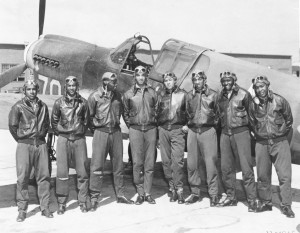
Tuskegee Airmen summary: Tuskegee Airmen is the name given to members of the U.S. Army Air Force units in World War II that were comprised primarily of African American flyers and maintenance crews, though a few white officers and trainers were also involved. The group compiled an impressive record, primarily in the Mediterranean Theater of Operations, despite facing frequent resistance to their presence in the formerly all-white Army Air Corps. Although the best-known Tuskegee Airmen were the fighter pilots of the 332nd Pursuit Group (99th, 100th, 301st, and 302nd fighter squadrons), the 477th Bombard Group (the first black bomber group) was also part of the Tuskegee Airmen. Pilots, navigators, bombardiers, maintenance and support staff, and instructors all played a role.
The Tuskegee Experiment
Service in the U.S. Army Air Corps had been limited to white personnel from its inception as part of the U.S. Army Signal Corps in 1907 until near the end of the 1930s. (The U.S. Air Force did not exist as a separate branch within the U.S. military until after World War II; however, during that war large air groups were designated Eighth Air Force, Fifteenth Air Force, etc.) The officer corps of the Army included a high number of men from the South, the region of the old Confederate States of America during the Civil War. The notion that blacks were inherently inferior to whites was still a wide-spread belief in most of the United States but particularly in the South, where virtually all aspects of life were racially segregated, so it is not surprising that Southern military men readily accepted—in fact, they had helped to write—a 1925 Army War College study of black troops in World War I that concluded Negroes, the racial term then in use, were subservient, mentally inferior and “barely fit for combat.”
In 1939, the National Association for the Advancement of Colored People (NAACP) took aim at the military’s segregationist policies. Negro newspapers and civic groups around the country began a public campaign to integrate the armed forces. The African-American Pittsburgh Courier especially agitated for acceptance of blacks in the Air Corps.
In 1941, the campaign turned to the courts. Yancey Williams, a student at Howard University, filed a suit backed by the NAACP to force the Air Corps to accept him into training. The Corps’ answer was to create a segregated unit to train black pilots and ground crews at Tuskegee Institute in Alabama.
That wasn’t what the NAACP had sought; it wanted full integration. The 239 black aviators who comprised the National Airmen’s Association also strongly objected, but to no avail. The plan was called the Tuskegee Experiment. Member of the Tuskegee Airmen believed it was called an experiment, “because we were supposed to fail.” Contrary to what is commonly believed, however, the training at Tuskegee was the equal of that at white facilities.
Read more @ http://www.redtail.org/the-airmen-a-brief-history/





Greetings…I’m Ron Brewington, a Tuskegee Airmen historian. While reading this article about the Tuskegee Airmen, I noted several errors:
1. Paragraph 1, sentence 3 – “….were the pilots of the 332nd Pursuit Group…” – Not true – They were the pilots of the 332nd Fighter Group, not 332nd Pursuit Group.
2. Paragraph 1, sentence 3 – “….the 477th Bombard Group….” – Not true – They were the pilots of the 477th Bombardment (Medium) Group.
Thank you!
Thank you for taking the time to provide updated info.